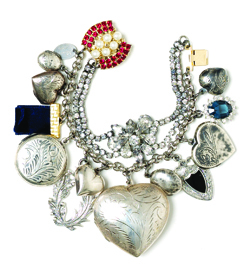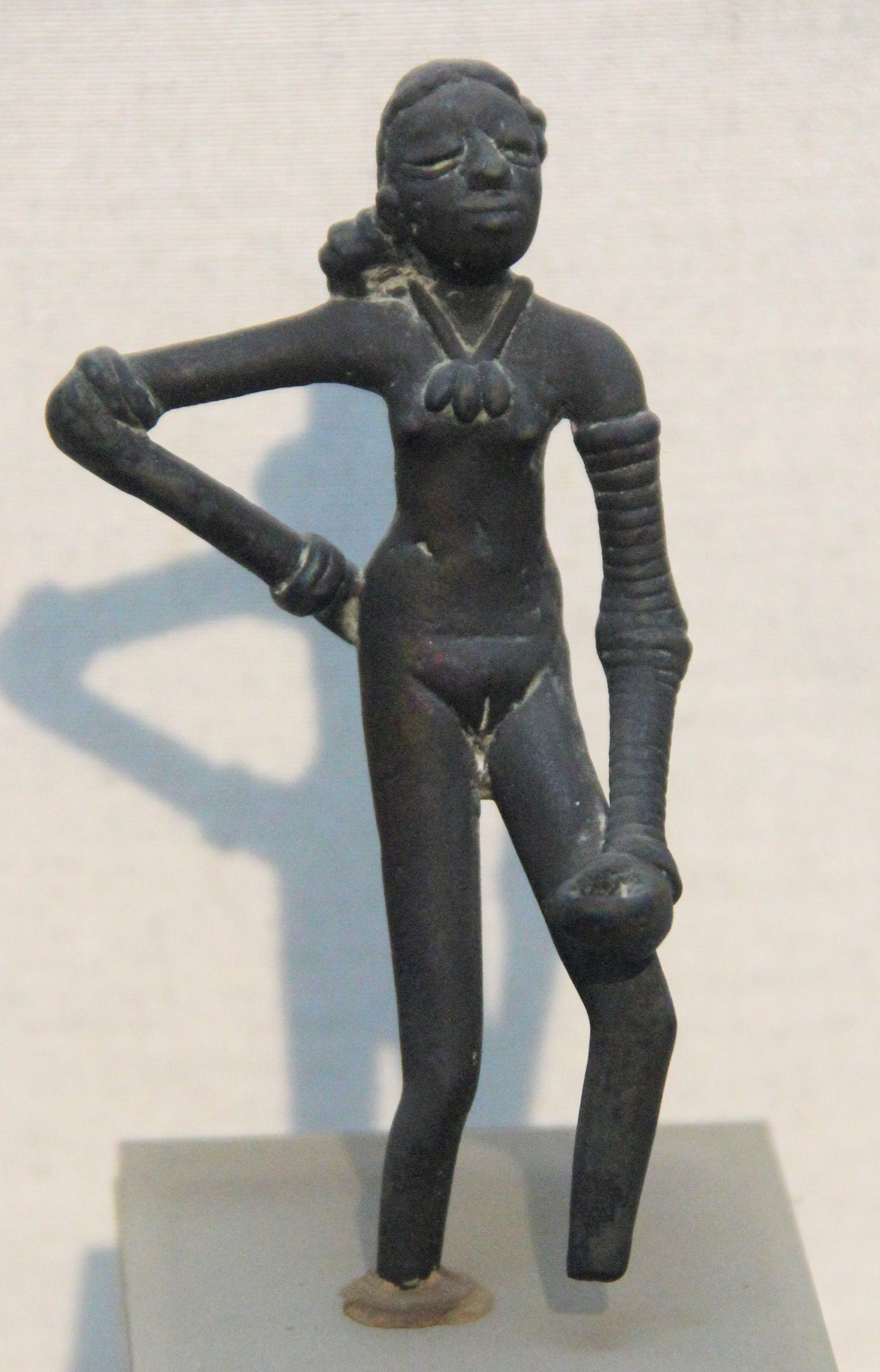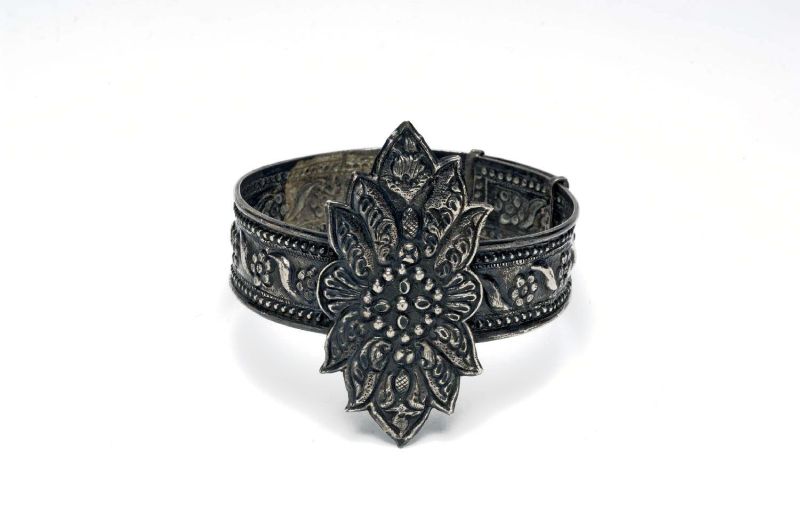|
Bracelet
A bracelet is an article of jewellery that is worn around the wrist. Bracelets may serve different uses, such as being worn as an ornament. When worn as ornaments, bracelets may have a supportive function to hold other items of decoration, such as charms. Medical and identity information can be marked on some bracelets, such as allergy bracelets, hospital patient-identification tags, and bracelet tags for newborn babies. Bracelets may be worn to signify a certain phenomenon, such as breast cancer awareness, for religious/cultural purposes or as a sign of LGBTQ pride. If a bracelet is a single, inflexible loop, it is often called a '' bangle''. When it is worn around the ankle it is called an ''ankle bracelet'' or '' anklet''. A ''boot bracelet'' is used to decorate boots. Bracelets can be manufactured from metal, leather, cloth, plastic, bead or other materials, and jewellery bracelets sometimes contain jewels, rocks, wood, shells, crystals, metal, or plastic hoops, ... [...More Info...] [...Related Items...] OR: [Wikipedia] [Google] [Baidu] |
Charm Bracelet
A charm bracelet is a type of bracelet which carries personal jewelled ornaments or "charms", such as decorative pendants or wikt:trinket, trinkets. The decorative charms usually carry personal or sentimental attachment by the owner. History The wearing of charms may have begun as a form of amulet or talisman to ward off evil spirits or bad luck. During the pre-historic period, jewellery charms would be made from shells, animal-bones and clay. Later charms were made out of gems, rocks, and wood. For instance, there is evidence from Africa that shells were used for adornments around 75,000 years ago. In Germany intricately carved mammoth tusk charms have been found from around 30,000 years ago. In ancient Egypt charms were used for identification and as symbols of faith and luck. Charms also served to identify an individual to the gods in the afterlife. During the Roman Empire, Christians would use tiny fish charms hidden in their clothing to identify themselves to other Christ ... [...More Info...] [...Related Items...] OR: [Wikipedia] [Google] [Baidu] |
Jewellery
Jewellery (or jewelry in American English) consists of decorative items worn for personal adornment such as brooches, ring (jewellery), rings, necklaces, earrings, pendants, bracelets, and cufflinks. Jewellery may be attached to the body or the clothes. From a western perspective, the term is restricted to durable Ornament (art), ornaments, excluding flowers for example. For many centuries metal such as gold often combined with gemstones, has been the normal material for jewellery, but other materials such as glass, shells and other plant materials may be used. Jewellery is one of the oldest types of archaeological artefact – with 100,000-year-old beads made from ''Nassarius'' shells thought to be the oldest known jewellery. The basic forms of jewellery vary between cultures but are often extremely long-lived; in European cultures the most common forms of jewellery listed above have persisted since ancient times, while other forms such as adornments for the nose or ankle, impo ... [...More Info...] [...Related Items...] OR: [Wikipedia] [Google] [Baidu] |
Allergy Bracelet
A medical identification tag is a small emblem or tag worn on a bracelet, neck chain, or on the clothing bearing a message that the wearer has an important medical condition that might require immediate attention. For emergency medical providers such as paramedic, paramedics and emergency physician, emergency physicians, medical identification tags are particularly useful in situations where the wearer is unconscious, altered mental status, very young, or otherwise unable to provide critical medical information. The tag is often made out of stainless steel or sterling silver. A wallet Identity document, card with the same information may be used instead of or along with a tag, and a stick-on medical ID tag may be added or used alone. A type of medic identification alert is the USB medical alert tag, essentially a USB flash drive with capacity to store a great deal of emergency information, including contacts and medical conditions. This information is accessible by any computer wi ... [...More Info...] [...Related Items...] OR: [Wikipedia] [Google] [Baidu] |
Bangle
A bangle is a traditionally rigid bracelet which is usually made of metal, wood, glass or plastic. These ornaments are worn mostly by women in the Indian subcontinent, Southeastern Asia, the Arabian Peninsula, and Africa. It is common to see a bride wearing glass bangles at weddings in India, Bangladesh, Pakistan, Nepal, Sri Lanka and in other Asian countries. Bangles may also be worn by young girls, and bangles made of gold or silver are preferred for toddlers. Some men and women wear a single bangle on the arm or wrist called ''kada'' or ''kara''. Chooda is a kind of bangle that is worn by Hindu/Sikh Punjabi women on their wedding day. It is a set of white and red bangles with stonework. According to tradition, a woman is not supposed to buy the bangles she will wear . Firozabad, Uttar Pradesh is India's largest producer of bangles. History Bangles made from sea shell, copper, bronze, gold, agate, chalcedony, etc. have been excavated from multiple archaeological sites t ... [...More Info...] [...Related Items...] OR: [Wikipedia] [Google] [Baidu] |
Anklet
An anklet, also called ''ankle chain'', ''ankle bracelet'' or ''ankle string'', is an ornament worn around the ankle. Barefoot anklets and toe rings historically have been worn for at least over 8,000 years by girls and women in Indus Valley, in Indian Subcontinent where it is commonly known as ''pattilu'', ''payal, golusu'' and sometimes as ''nupur''. They have also been worn by Egyptian women since predynastic times. In the United States both casual and more formal anklets became fashionable from the 1930s to the late–20th century. While in Western popular culture both younger men and women may wear casual leather anklets, they are popular among barefoot women. Formal anklets (of silver, gold, or beads) are used by some women as fashion jewellery. Anklets are an important piece of jewellery in Indian marriages, worn along with saris. Occasionally, anklets on both ankles are joined by a chain to limit the step. This practice was once prevalent in Southeast Asia, where th ... [...More Info...] [...Related Items...] OR: [Wikipedia] [Google] [Baidu] |
Breast Cancer Awareness
Breast cancer awareness is an effort to raising awareness, raise awareness and reduce the Social stigma, stigma of breast cancer through education about Breast cancer screening, screening, Cancer signs and symptoms, symptoms, and Breast cancer treatment, treatment. Supporters hope that greater knowledge will lead to earlier detection of breast cancer, which is associated with higher Cancer survival rates, long-term survival rates, and that money raised for breast cancer will produce a reliable, permanent Cure for cancer, cure. Breast cancer advocacy and awareness efforts are a type of health advocacy. Breast cancer advocates fundraising, raise funds and Lobbying, lobby for better care, more knowledge, and more patient empowerment. They may conduct educational campaigns or provide free or low-cost services. Breast cancer culture, sometimes called pink ribbon culture, is the cultural outgrowth of breast cancer advocacy, the social movement that supports it, and the larger women' ... [...More Info...] [...Related Items...] OR: [Wikipedia] [Google] [Baidu] |
Arm Ring
An arm ring, also known as an armlet or an armband, is a band of metal, usually a precious metal, worn as jewelry or an ornament around the biceps of the upper arm. The arm ring is similar to a bracelet or bangle, though it must be shaped and sized to fit snugly to the upper arm. Often, when the word ''"ring"'' occurs in Bronze-Age heroic literature it refers to an arm ring, rather than a finger ring. Within the context of the Scandinavian Bronze Age, archeological digs of graves suggest that arm rings were most commonly worn by men. Arm rings have also been found in Britain and Ireland, with artifacts dating from the Bronze Age till the Viking Age. Archeological discoveries of Bronze Age arm rings in Denmark suggest they were common Votive offerings during that period, found purposefully deposited in bodies of water or buried near large stones, hills, or barrows. It is believed that arm rings may have been bestowed as gifts by powerful lords to secure or maintain bonds ... [...More Info...] [...Related Items...] OR: [Wikipedia] [Google] [Baidu] |
Wrist
In human anatomy, the wrist is variously defined as (1) the carpus or carpal bones, the complex of eight bones forming the proximal skeletal segment of the hand; "The wrist contains eight bones, roughly aligned in two rows, known as the carpal bones." (2) the wrist joint or radiocarpal joint, the joint between the radius and the carpus and; (3) the anatomical region surrounding the carpus including the distal parts of the bones of the forearm and the proximal parts of the metacarpus or five metacarpal bones and the series of joints between these bones, thus referred to as ''wrist joints''. "With the large number of bones composing the wrist (ulna, radius, eight carpas, and five metacarpals), it makes sense that there are many, many joints that make up the structure known as the wrist." This region also includes the carpal tunnel, the anatomical snuff box, bracelet lines, the flexor retinaculum, and the extensor retinaculum. As a consequence of these various definitions, f ... [...More Info...] [...Related Items...] OR: [Wikipedia] [Google] [Baidu] |
Ancient Egypt
Ancient Egypt () was a cradle of civilization concentrated along the lower reaches of the Nile River in Northeast Africa. It emerged from prehistoric Egypt around 3150BC (according to conventional Egyptian chronology), when Upper and Lower Egypt were amalgamated by Menes, who is believed by the majority of List of Egyptologists, Egyptologists to have been the same person as Narmer. The history of ancient Egypt unfolded as a series of stable kingdoms interspersed by the "Periodization of ancient Egypt, Intermediate Periods" of relative instability. These stable kingdoms existed in one of three periods: the Old Kingdom of Egypt, Old Kingdom of the Early Bronze Age; the Middle Kingdom of Egypt, Middle Kingdom of the Middle Bronze Age; or the New Kingdom of Egypt, New Kingdom of the Late Bronze Age. The pinnacle of ancient Egyptian power was achieved during the New Kingdom, which extended its rule to much of Nubia and a considerable portion of the Levant. After this period, Egypt ... [...More Info...] [...Related Items...] OR: [Wikipedia] [Google] [Baidu] |
Boot
A boot is a type of footwear. Most boots mainly cover the foot and the ankle, while some also cover some part of the lower calf. Some boots extend up the leg, sometimes as far as the knee or even the hip. Most boots have a heel that is clearly distinguishable from the rest of the sole, even if the two are made of one piece. Traditionally made of leather or rubber, modern boots are made from a variety of materials. Boots are worn both for their functionality and for reasons of style and fashion. Functional concerns include: protection of the foot and leg from water, mud, pestilence (infectious disease, insect bites and stings, snake bites), extreme temperatures, sharp or blunt hazards (e.g. work boots may provide steel toes), physical abrasion, corrosive agents, or damaging radiation; ankle support and traction for strenuous activities such as hiking; and durability in harsh conditions (e.g. the underside of combat boots may be reinforced with hobnails). In some cases, th ... [...More Info...] [...Related Items...] OR: [Wikipedia] [Google] [Baidu] |
Exoskeleton
An exoskeleton () . is a skeleton that is on the exterior of an animal in the form of hardened integument, which both supports the body's shape and protects the internal organs, in contrast to an internal endoskeleton (e.g. human skeleton, that of a human) which is enclosed underneath other soft tissues. Some large, hard and non-flexible protective exoskeletons are known as mollusc shell, shell or armour (anatomy), armour. Examples of exoskeletons in animals include the arthropod exoskeleton, cuticle skeletons shared by arthropods (insects, chelicerates, myriapods and crustaceans) and tardigrades, as well as the corallite, skeletal cups formed by hardened secretion of stony corals, the test (biology), test/tunic of sea squirts and sea urchins, and the prominent mollusc shell shared by snails, bivalvia, clams, tusk shells, chitons and nautilus. Some vertebrate animals, such as the turtle, have both an endoskeleton and a turtle shell, protective exoskeleton. Role Exoskeletons c ... [...More Info...] [...Related Items...] OR: [Wikipedia] [Google] [Baidu] |
Hinged Cuff Bracelet MET 26
A hinge is a mechanical bearing that connects two solid objects, typically allowing only a limited angle of rotation between them. Two objects connected by an ideal hinge rotate relative to each other about a fixed axis of rotation, with all other translations or rotations prevented; thus a hinge has one degree of freedom. Hinges may be made of flexible material or moving components. In biology, many joints function as hinges, such as the elbow joint. History Ancient remains of stone, marble, wood, and bronze hinges have been found. Some date back to at least Ancient Egypt, although it is nearly impossible to pinpoint exactly where and when the first hinges were used. In Ancient Rome, hinges were called cardō and gave name to the goddess Cardea and the main street Cardo. This name cardō lives on figuratively today as "the chief thing (on which something turns or depends)" in words such as ''cardinal''. According to the Oxford English Dictionary, the English word ''hinge' ... [...More Info...] [...Related Items...] OR: [Wikipedia] [Google] [Baidu] |









